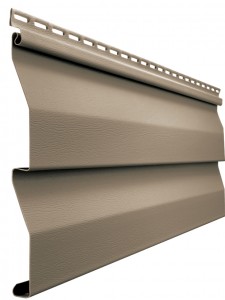Though concerns have been raised about the effects of vinyl siding on the environment due to its byproducts, particularly when it is burned, some experts assert that the risks are exaggerated. They say that vinyl siding has some advantages relative to other types of siding in terms of its environmental safety.
Vinyl remains the most popular choice of siding among  homeowners due to its affordability and relatively easy maintenance. This siding type is composed mainly of polyvinyl chloride, or PVC, which emits dioxin and chlorine gas when burned. During the manufacturing of PVC large amounts of dioxin may be released into the environment. Dioxin is a known carcinogen and chlorine gas that was used as a chemical weapon during World War I. It is a respiratory irritant that can lead to death by asphyxiation at high levels of exposure. Occupants have been known to die from the fumes emitted by PVC during a house fire before the fire even reached them.
homeowners due to its affordability and relatively easy maintenance. This siding type is composed mainly of polyvinyl chloride, or PVC, which emits dioxin and chlorine gas when burned. During the manufacturing of PVC large amounts of dioxin may be released into the environment. Dioxin is a known carcinogen and chlorine gas that was used as a chemical weapon during World War I. It is a respiratory irritant that can lead to death by asphyxiation at high levels of exposure. Occupants have been known to die from the fumes emitted by PVC during a house fire before the fire even reached them.
There is a common misconception about the materials within PVC and one of them has been about phthalates. Phthalates, which disrupt the hormone system, once was added to PVC to improve its performance, and these substances were known to cause infertility and developmental problems in children. These are now removed from most vinyl PVC based materials in the United States. The only product in the U.S. that did not use phthalates as an ingredient was, specifically, vinyl siding.
Despite concerns about the gases emitted by vinyl siding when it is burned, some experts believe the risks are exaggerated and that vinyl siding comes with certain environmental benefits relative to other siding types. The Vinyl Siding Institute, a trade association, points out that only 2% of the dioxin that contaminates the environment is created by the manufacturing of PVC. By contrast, it points out that the production of concrete, which is used in fiber cement siding and masonry siding, creates more dioxin.
In 2008 and 2009, a study was conducted by Newport Ventures, an independent energy consulting firm, to discover if insulated vinyl siding keeps homes in the state of New York warmer during winter months than those using a standard fiber cement siding for houses. The study demonstrated that insulated vinyl siding keeps homes significantly warmer during the winter months than the standard fiber cement siding product. The study also demonstrated that insulated vinyl siding would save homeowners in the state of New York an average of $56 per year in reduced energy consumption, which would benefit the environment.
According to the Vinyl Siding Institute, the durability of vinyl siding continually improves over time. Given improved color retention, vinyl siding does not have to be painted as often as wood and other types of siding, which can lower the amount of lead and other additives from paint which contaminate the environment. Vinyl siding is also recyclable.
To conclude, though some have raised concerns about the production of dioxin during the manufacturing of PVC and the use of phthalates as an additive, advocates of vinyl siding instead point to the environmental benefits of vinyl siding compared to other types of siding. While there remains strong disagreement on the advantages and disadvantages of vinyl siding, it remains enormously popular among homeowners and will likely remain a popular choice for the foreseeable future.
